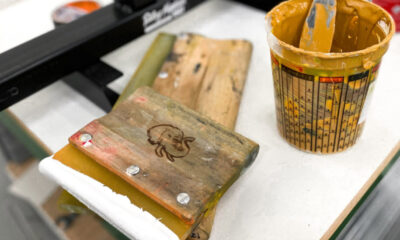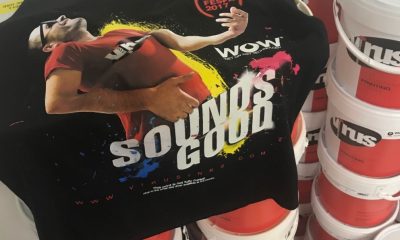Inks & Coatings
Published
12 years agoon

Splat. You can picture a tiny drop of ink thrust from a piezoelectric inkjet nozzle landing on a substrate. The ink droplet will not remain intact for long. Even under calmer conditions—like delicately depositing the drop onto a sheet of paper—it tends to spread out; increasing in diameter and altering its shape. The dimensional change from spreading, called dot or drop gain, is a nagging problem for digital printers. In a world where precise drop size and location determines print quality, drop gain tends to blur images and muddle colors with a loss of resolution, color integrity and gloss control. It is a finicky problem, confounded by a lot of variables, but one that is being helped by a new technology: UV LEDs.
UV-LED
UV LEDs are light sources that allow digital printers to gel or freeze UV ink droplets quickly before they have time to spread out (Figure 1). This is possible because the UV-LED light sources are more compact than conventional curing systems and can be easily positioned between successive print heads. The process of freezing ink droplets between print heads is called pinning and is somewhat different from fully curing the ink (Figure 2). While pinning stops the drop from spreading, it leaves the ink flexible and soft enough for proper inter-coat adhesion to other ink droplets and for further handling.
Full or final curing ordinarily occurs at the end of the process and transforms the ink into a more rigid film with the required final surface properties. All pinned inks must still pass underneath a final cure UV source to be fully cured.
Pinning is also different from so-called inter-deck curing found on some larger offset printing presses, where colors are early completely cured near the drum before other colors are applied downstream. A close-to-full cure is necessary with an offset process because the transfer plates make physical contact with the cured surface during printing. Pinning is possible with inkjet processes because inkjet printing requires no physical contact with the cure surface (Figure 3). The extent of dot or drop gain depends on properties of the ink, substrate, and the process environment.
Drop gain
Just as it’s easier to shoot water from a squirt gun than it is cream cheese; thinner, less viscous inks jet more easily. UV jettable inks are typically in the 10-15 cP viscosity range and tend to spread more easily than thicker inks. Any number of formulating tweaks for color, gloss, or rheological properties can have unintended consequences when it comes to drop gain, and so there’s not likely to be a one-size-fits-all setting.
The substrate plays an equally important though often less predictable role in determining drop gain. While some materials absorb ink and have varying degrees of porosity, other materials present a slick surface making it easier for inks to spread around more easily. For example, coated papers designed to promote wetting also promote drop gain. With an ever expanding choice of paper and plastic films and the advent of variable data printing systems designed for small production runs on a range of parts, it is unrealistic to expect a “set it and forget it” solution.
Other nuts and bolts of the process also affect drop gain—such as the web or press speed, the distance from the print head to the substrate, and the local airflow, heat and humidity. In the end, a daunting combination of variables from ink to substrate to process requires a pinning system that can be quickly, but precisely fine tuned—sometimes color-by-color, to achieve the needed resolution. UV LEDs provide that level of simple, but effective control over the pinning process.
Difference from UV
As the name implies, UV LEDs are an ultraviolet variety of light-emitting diodes. They differ dramatically from traditional UV lamps used for printing both in how they produce UV, and in their benefits. Traditionally, lamp suppliers have produced UV by energizing a small amount of mercury that is sealed in a quartz tube. When high voltage is applied to the lamps electrodes, (or with microwave lamps, when the tube is placed in a microwave generator), UV (along with a large amount of visible light and infrared heat) is created. So the output spectrum of mercury lamps contains a large number of peaks over a broad range of wavelengths that extend from 200nm to well into the IR region above 1000 nm.
UV LEDs, on the other hand, are semiconductor devices; modern cousins of the LED on your garage door opener except that UV LEDs emit light in the longer-wavelength portion of the UV spectrum. The exact output of the LED is chemistry dependent, but typically the output is a relatively monochromatic or narrow peak of energy somewhere between 365-405 nm
At first, the more specific, narrow bandwidth output of the LED caused UV chemists some fits as they scurried to adapt ink formulations to these new sources. But the benefits of UV LEDs for digital printing clearly made this effort worthwhile, because UV LEDs offer many advantages that arc lamps do not. For example, they do not generate dangerous short wavelength UV that can be a safety hazard, and they do not produce ozone. They do not contain mercury, another potential safety hazard, or use high voltages.
But LEDs are also much cooler than arc lamps, and they can be turned on and off instantly without the need for shutters. LEDs are compact in size, and produce more uniform light sources that last much longer than arc lamps. But it is the ability to precisely control the UV output of the light source, along with their compact size, and cool-running temperatures that limit heat build, that make UV LEDs ideal for pinning inks. Compact UV LEDs can be located in the tight confines between inkjet heads, a trick that would be impossible for arc lamps.
Figure 1 illustrates the ability of UV-LED pinning lamps to improve the quality of digital images by limiting drop gain on a difficult substrate. Without pinning, each color spreads as it is applied, mixing and muddling with other droplets. With pinning, the droplets remain distinct and sharp.
The use of state-of-the-art UV-LED technology to improve dot gain is advancing digital printing on two related fronts. While pinning helps to produce higher quality images with existing technology, it also makes it possible for press designers to achieve a higher perceived resolution with less expensive or complex jetting hardware. After all, resolution is not determined by the number of dots applied per inch alone, but also by the distinctness of those droplets to the reader’s eye. If ink droplets are fuzzy, or mingled with others, even a high density of droplets per inch can be a wasted investment.
In conclusion
While there is broad agreement that pinning improves image quality, there is no consensus yet regarding the ideal settings needed for optimal pinning. Ink formulators, UV-pinning-system manufacturers, and integrators are experimenting with UV settings, timing, and ink sets to find the answers. The activity is a strong indicator that more and more systems are, and will be, incorporating pinning into the inkjet printing process.
Paul Mills, Integration Technology, has been involved in UV curing since 1994. He has participated in a number of innovations in UV including UV powder coatings development, robotic UV curing and the development UV LED light sources. Paul holds BA and MA in economics, and has been a longtime member and board member of RadTech.
Jennifer Heathcote is general manager, North America (based in Chicago, Illinois), for Integration Technology. Heathcote received a B.S. in mechanical engineering from Purdue University and earned her MBA at The Ohio State University. Integration Technology, founded in 2000 and headquartered in Oxfordshire, England, is a supplier of both conventional mercury lamps and UV LED light sources to a wide range of industries including the global graphic arts and printing markets.
.

Subscribe

Magazine
Get the most important news
and business ideas from Screenprinting Magazine.
Most Popular
-

 Case Studies2 months ago
Case Studies2 months agoHigh-Density Inks Help Specialty Printing Take Center Stage
-

 Art, Ad, or Alchemy2 months ago
Art, Ad, or Alchemy2 months agoF&I Printing Is Everywhere!
-

 Andy MacDougall2 months ago
Andy MacDougall2 months agoFunctional and Industrial Printing is EVERYWHERE!
-

 Columns3 weeks ago
Columns3 weeks ago8 Marketing Mistakes Not to Make When Promoting Your Screen Printing Services Online
-

 Editor's Note3 weeks ago
Editor's Note3 weeks agoLivin’ the High Life
-

 Marshall Atkinson3 weeks ago
Marshall Atkinson3 weeks agoHow to Create a Winning Culture in Your Screen-Printing Business
-

 Thomas Trimingham2 months ago
Thomas Trimingham2 months ago“Magic” Marketing for Screen Printing Shops
-

 News & Trends2 months ago
News & Trends2 months agoWhat Are ZALPHAS and How Can You Serve Them in Your Print Business?





